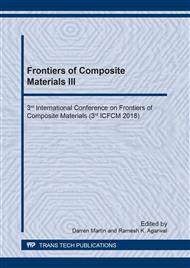p.9
p.15
p.21
p.27
p.33
p.39
p.45
p.51
p.57
Mechanical Properties of Unidirectional Flax Fabric-Reinforced Furan Composites: Effect of Alkaline Treatment and Silane Coupling Treatment
Abstract:
Composite materials based on bio-derived furan resin and natural fiber as reinforcing elements were studied. The purpose of this research is to improve the mechanical properties of this composite material by focusing on the natural fiber treatment methods. Unidirectional flax fabric was pretreated by alkaline treatment, silane coupling treatment, and the combination between alkaline and silane treatment before impregnating with furan resin. Three-point bending test, SEM observation, and ATR-IR analysis were carried out to evaluate the effects of treatment methods on the composite samples. Results reveal that the flexural strength of the composite was increased to 215MPa, 232MPa, 247MPa for alkaline, silane, and alkaline-silane treated composites respectively while the flexural strength of the untreated composite sample is 200MPa. SEM images show the effects of alkaline treatment on a single flax fiber at different treatment durations. The coupling of silane on the surface of flax fiber was confirmed by ATR-IR.
Info:
Periodical:
Pages:
33-38
Citation:
Online since:
April 2019
Keywords:
Price:
Сopyright:
© 2019 Trans Tech Publications Ltd. All Rights Reserved
Share:
Citation:


